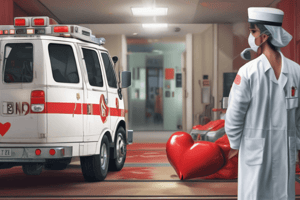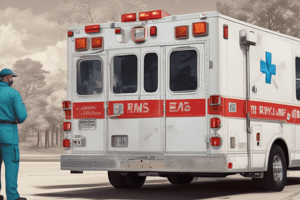Podcast
Questions and Answers
What are the five parts of the patient assessment process?
What are the five parts of the patient assessment process?
- Secondary assessment (correct)
- Reassessment (correct)
- Primary assessment (correct)
- Scene size-up (correct)
- History taking (correct)
What is scene size-up?
What is scene size-up?
A quick assessment of the scene and surroundings to provide information about scene safety and the mechanism of injury or nature of illness before entering.
What does Situational Awareness refer to?
What does Situational Awareness refer to?
Knowledge and understanding of your surroundings and situation and the risks they potentially pose to safety.
What is the Incident Command System (ICS)?
What is the Incident Command System (ICS)?
What is the purpose of Triage?
What is the purpose of Triage?
What is a Primary Survey?
What is a Primary Survey?
What are spontaneous respirations?
What are spontaneous respirations?
What happens during inspiration?
What happens during inspiration?
When assessing breathing, obtain what info?
When assessing breathing, obtain what info?
What accessory muscles are used in labored breathing?
What accessory muscles are used in labored breathing?
What are inadequate breathing signs in pediatrics?
What are inadequate breathing signs in pediatrics?
What is the tripod position?
What is the tripod position?
What is the sniffing position?
What is the sniffing position?
What does respiratory failure indicate?
What does respiratory failure indicate?
How many breaths per minute should be given to a patient with a pulse but not breathing?
How many breaths per minute should be given to a patient with a pulse but not breathing?
What is perfusion evaluated by?
What is perfusion evaluated by?
What is cyanosis?
What is cyanosis?
What is jaundice?
What is jaundice?
What are the signs of liver disease?
What are the signs of liver disease?
What is the normal skin temperature?
What is the normal skin temperature?
What should be assessed when evaluating skin?
What should be assessed when evaluating skin?
What does 'diaphoretic' mean?
What does 'diaphoretic' mean?
How do you assess capillary refill in newborns or infants?
How do you assess capillary refill in newborns or infants?
What does the AVPU scale stand for?
What does the AVPU scale stand for?
What is orientation in patient assessment?
What is orientation in patient assessment?
What is the most common test for orientation?
What is the most common test for orientation?
What is the GCS scale used for?
What is the GCS scale used for?
What is a rapid full body scan?
What is a rapid full body scan?
What should be assessed during a rapid full body scan?
What should be assessed during a rapid full body scan?
What is known as the golden hour?
What is known as the golden hour?
What does the Platinum 10 minutes refer to?
What does the Platinum 10 minutes refer to?
What is significant MOI?
What is significant MOI?
What is history taking (SAMPLE)?
What is history taking (SAMPLE)?
What is focal pain?
What is focal pain?
What is diffuse pain?
What is diffuse pain?
What is referred pain?
What is referred pain?
What are pertinent negatives?
What are pertinent negatives?
What are SAMPLE medication questions?
What are SAMPLE medication questions?
What sexual history questions should be asked?
What sexual history questions should be asked?
What is the purpose of the Secondary Assessment?
What is the purpose of the Secondary Assessment?
What vital signs should be assessed during the secondary assessment?
What vital signs should be assessed during the secondary assessment?
What is pulse oximetry?
What is pulse oximetry?
What is the normal SpO2 range?
What is the normal SpO2 range?
What is electronic blood pressure measurement?
What is electronic blood pressure measurement?
What is the purpose of stepped deflation?
What is the purpose of stepped deflation?
What is capnometry?
What is capnometry?
What is capnography?
What is capnography?
What does end-tidal CO2 refer to?
What does end-tidal CO2 refer to?
How is end-tidal CO2 measured?
How is end-tidal CO2 measured?
What is the end-tidal CO2 range?
What is the end-tidal CO2 range?
What does a colorimetric device provide?
What does a colorimetric device provide?
What do colorimetric CO2 color readings indicate?
What do colorimetric CO2 color readings indicate?
When should blood glucose be assessed?
When should blood glucose be assessed?
What is the normal blood glucose level?
What is the normal blood glucose level?
What should be evaluated during a focused assessment for chest pain?
What should be evaluated during a focused assessment for chest pain?
What should be evaluated during a focused assessment of abdominal pain?
What should be evaluated during a focused assessment of abdominal pain?
What should be evaluated during a focused assessment for shortness of breath?
What should be evaluated during a focused assessment for shortness of breath?
What indicators should be assessed during a focused assessment for dizziness?
What indicators should be assessed during a focused assessment for dizziness?
What should be evaluated during a focused assessment for pain in bones/joints?
What should be evaluated during a focused assessment for pain in bones/joints?
What are adventitious sounds?
What are adventitious sounds?
What do wheezing breath sounds suggest?
What do wheezing breath sounds suggest?
What are crackle breath sounds indicative of?
What are crackle breath sounds indicative of?
What do rhonchi breath sounds indicate?
What do rhonchi breath sounds indicate?
What do stridor breath sounds indicate?
What do stridor breath sounds indicate?
What causes stridor?
What causes stridor?
What is a pleural friction rub?
What is a pleural friction rub?
What is tidal volume?
What is tidal volume?
What is the normal tidal volume of an adult?
What is the normal tidal volume of an adult?
What does blood pressure (BP) measure?
What does blood pressure (BP) measure?
What is systolic pressure?
What is systolic pressure?
What is diastolic pressure?
What is diastolic pressure?
When should a neurological exam be performed?
When should a neurological exam be performed?
What does one dilated pupil indicate?
What does one dilated pupil indicate?
What is crepitus?
What is crepitus?
What does JVD with a patient sitting up indicate?
What does JVD with a patient sitting up indicate?
What is paradoxical motion?
What is paradoxical motion?
Paradoxical motion is a sign of a _______.
Paradoxical motion is a sign of a _______.
What is guarding reflex?
What is guarding reflex?
What does rigidity refer to?
What does rigidity refer to?
What is rebound tenderness?
What is rebound tenderness?
What does rebound tenderness (Blumberg's sign) indicate?
What does rebound tenderness (Blumberg's sign) indicate?
What are the steps in the reassessment process?
What are the steps in the reassessment process?
Flashcards are hidden until you start studying
Study Notes
Patient Assessment Process
- Five key components: Scene size-up, Primary assessment, History taking, Secondary assessment, Reassessment.
- Scene size-up includes assessing the safety and mechanism of injury before patient care begins.
Scene Size-Up and Awareness
- Scene size-up helps determine safety and injury/illness nature.
- Situational awareness refers to understanding surroundings and potential safety risks for the EMS team.
Incident Command System (ICS)
- ICS is a structured approach for managing disasters and mass-casualty incidents with section chiefs reporting to an incident commander.
Triage and Emergency Assessments
- Triage involves medical screening to prioritize patient needs and treatment locations.
- Primary survey checks for life-threatening emergencies focusing on airway, breathing, and circulation.
Breathing and Respiratory Assessment
- Spontaneous respirations occur without assistance.
- Inspections during breathing assessments include respiratory rate (RR), depth, rhythm, and distress indicators.
Positions and Signs Indicating Breathing Difficulties
- Tripod position indicates difficulty breathing; patient leans forward on arms.
- Sniffing position helps keep the airway open; patient’s head is slightly forward.
Respiratory Failure and Distress
- Respiratory failure occurs when blood oxygenation is inadequate for body needs.
- Signs of inadequacy in pediatric patients include nasal flaring and seesaw breathing.
Assessing Breathing and Perfusion
- During breath assessments, seek information on respiratory rate, quality, distress level, and accessory muscle use.
- Perfusion evaluation involves checking skin tone, capillary refill, temperature, and moisture.
Skin Assessment Indicators
- Cyanosis signals oxygen deficiency leading to bluish skin; jaundice indicates liver issues with yellowing skin.
- Normal skin temperature averages 98.6°F; assess color, temperature, and moisture during skin evaluations.
Mental Status Evaluation
- Orientation checks mental status through memory and cognition by assessing person, place, time, and event.
- The AVPU scale measures responsiveness: Alert, Verbal, Pain, Unresponsive.
Secondary and Focused Assessment
- Secondary assessment includes obtaining vital signs and performing a systematic physical exam.
- Focused assessments evaluate specific complaints like chest pain or abdominal pain, checking vital signs and trauma presence.
Breathing Sounds and Indicators
- Abnormal breath sounds include wheezing (lower airway obstruction), crackles (CHF indication), and stridor (upper airway obstruction).
- Rhonchi suggests mucus in lungs; pleural friction rub indicates irritation of lung surfaces.
Vital Signs and Monitoring
- Normal blood glucose is between 80-120 mg/dL; diabetic or altered patients should have glucose assessed.
- Blood pressure gauges arterial pressure during heart contractions (systolic) and between (diastolic).
Neurological and Abdominal Assessment
- Neurological exams are critical when there's a change in mental status or head injury.
- Guarding reflex indicates peritonitis; rebound tenderness suggests abdominal irritation or inflammation.
Reassessment Steps
- Reassessment should repeat primary assessments and vital signs while reevaluating the chief complaint and any interventions applied.
- The Golden Hour emphasizes urgency for treating trauma and shock, while Platinum 10 Minutes sets optimal on-scene time goals for patient care.
Studying That Suits You
Use AI to generate personalized quizzes and flashcards to suit your learning preferences.




